Tuesday, September 24: Alice Springs to Yulara
From the mountains to the prairies
Tuesday starts early as the bus picks us up for the long ride to the town of Yulara, where the Ayers Rock Resort is. In fact, Yulara is the Ayers Rock Resort, as there’s nothing else to the town except for the resort (it’s got its own post office, bank, and supermarket). It’s about 350 km (220 miles) from Alice Springs to Yulara, so we’re in a nice coach (bus). It’s still early, though.
We started out driving south along the Stuart Highway, the only road that connects Darwin on the north coast with Adelaide on the south coast, and stopped for a bit at Fullerton’s Camel Farm. Camels are big in Australia, not only for riding in the Outback (much better than horses) but also for eating and even exporting (they export camels to Saudi Arabia, believe it or not). This particular farm sponsors a big camel race each year. For just AU$4 you could ride on a camel in a track around the yard; it was something I hadn’t done since I was a kid, so this was a bit of nostalgic goofy fun.
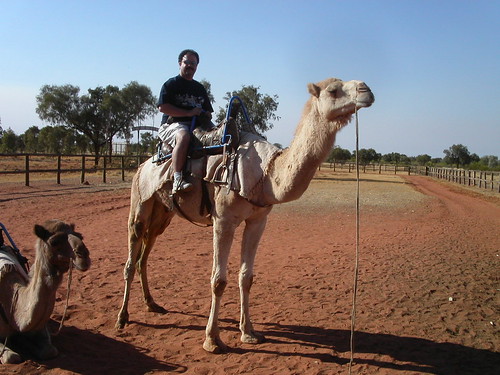
The next pit stop was in Mt. Ebeneezer, then we turned off the Stuart (aka “The Track” – “Up the Track” is north of Alice Springs, and “Down the Track” is south) onto the Lasseter Highway. On these highways we saw several “road trains”, which is an 18-wheeler cab hauling three trailers instead of just one.
As we got closer to Yulara, we started seeing more evidence of recent brush fires. The fires are a natural part of the desert ecosystem out here, as the fires burn off old grass to make room for new growth, and the heat activates or releases certain seeds. There’s no real attempt to stop or control the fires, as long as they don’t encroach on human-occupied lands. Even the fires are part of the aboriginal life – the fires drive animals out of the brush, for example, and they use the black and white ash from various plants as part of their body painting rituals. We did see fire from the road, and in some places the smoke was thick high in the air; the smoke will have an effect on the sunset colors at Ayers Rock later, but it depends on how much.
Mt. Connor came up on our left, about 100 km from Yulara. This is often mistaken for Ayers Rock by those who don’t know the difference, but this has a flat top (mesa) whereas Ayers Rock doesn’t.
Then we finally got to Yulara about 1 pm, enough time to unpack and relax a bit before the afternoon trip to the Olgas and the sunset viewing. Ayers Rock Resort is actually a collection of about 7 different hotels, aimed at a different segment of the tourist dollar, from a five-star hotel to a campground, they’re more than willing to provide all kinds of accommodations. I stayed in the lower end, at the Outback Pioneer. As the name suggests, it’s not heavy on amenities in the room, but I won’t be spending all my time there anyway. There’s a queen-sized bed and two single bunkbeds in the room, plus a TV, refrigerator, and coffee machine. The bathrooms are shared, though some with “ensuite” (bathrooms in the room) were available. The whole setup reminds me of summer camp, actually.
The tour bus takes us to a viewing site for the Olgas (named after the wife of a German minister at the time; local name Kata Tjutka), which are an amazing site in a land of amazing sites. Imagine a huge sandstone rock miles long, sticking up out of the ground with pretty much nothing else around except desert plains, then imagine the effects of millions of years of erosion carving channels deep into the rock, effectively separating the various pieces and rounding them off. Now imagine that there are 38 or so of these mounds, that’s the Olgas. We went up to the mountains for a walk-through between two of the domes. The rust-red dust gets everywhere from the ankle down when you walk, so my formerly white shoes have a distinctly burnt orange hue. My socks, too. Going into the Olgas looks like some nightmarish world of fire-dust, enormous boulders of sandstone and aggregate rocks, with stubborn spinifex grass growing everywhere, and you wonder how anything can live out here.
The highlight of the evening was the sunset viewing of Ayers Rock (named after an Australian minister when it was “discovered” by the white man; local name Uluru). Each sunset is different, the tour guides tell us, as the local atmospheric conditions affect the reds, oranges, yellows, and purples that appear on the mountain as the sun goes down. We were told that the rock looked brownish much earlier than usual as a result of the fires we saw earlier. There were no brilliant colors this night, just subtle changes in the browns and reds, but still a sight to see – this monolith of a rock sticking up out of the otherwise-unbroken desert plains.
Back at Yulara, I went to dinner with Dana and Theresa, two women on “holiday” (vacation) from Melbourne (which they pronounce as “mel-bin”, rhyming with Melvin). They had been on the tour with me since yesterday at Simpson’s Gap and Standley Chasm, and I had gotten friendly with them over the last two days of touring. While waiting for the shuttle bus, I took some time to look at the night sky, which I hadn’t really had a chance to do the whole trip. Out here in the middle of nowhere, there’s no light pollution and little air pollution (anything is due to the smoke from fires). I was able to see the Milky Way Galaxy from horizon to horizon, which I haven’t been able to do since I was in Chile in 1982 (and even then, the horizons were blocked by mountains on either side). The sky is so black I could see even the dim stars, in an unfamiliar alien sky.
We went to dinner at Gecko’s, a Mediterranean restaurant here at Ayers Rock Resort (I had the tandoori chicken pizza), and during and after dinner we discussed everything from our countries reactions to September 11 to cultural differences to how Americans and Australians see each other to the little things that are different to NASA stuff. I was then surprised when they “shouted” my dinner – the Aussie custom of buying a round of drinks for the group is called a shout – that is, they picked up the check. It was their way of showing Aussie hospitality when they could. I was deeply impressed and flattered, and I’ll send them something Texas-related as a thanks when I get back.
After staying up later than I wanted in order to get my laundry done, I went to bed around 1:30. Wakeup time is only in 3-1/2 hours, we will be catching the 5:30 a.m. shuttle out to Uluru for the sunrise viewing. Bleah. I’m on vacation, I shouldn’t have to be getting up this early.
Wednesday, September 25: Yulara
Climb every mountain
This is way too early. The only consolation is that when I look at the sky pre-dawn I finally see some familiar constellations – Orion the Hunter and Taurus the Bull are instantly recognizable. The bus takes us to the first stop at the base of the mountain around 6:20 or so, where those who want to climb the Rock or do the walk around the base can do so, the rest go out to the sunrise viewing site for champagne and then a guided tour. I opted to try to climb the Rock. It’s “only” 345 meters (1131 feet) vertical, but the first part, the toughest, looks like a very steep 30 degree slope. There’s a chain to help you climb, but you need good feet, strong lungs, and strong legs. The first part is flat enough that there’s no chain, but it’s hardly flat at all. The large rocks at the bottom, which end some distance from the beginning of the chain, aren’t called “Chicken Rock” for nothing. I had every intention of climbing the Rock, but my feet gave out first. I had only gone about 10 minutes up before my feet started to feel signs of cramping, and I was only halfway up the steepest part (it supposedly gets less steep and also has ups and downs on the way to the top). So I decided that I had made the attempt and that was good enough. I can say I climbed Ayers Rock, I just don’t have to say that I climbed up to the top. I wasn’t the only one – we started pretty early in the day, right around sunrise when the temperature is lower and there were people coming down already who hadn’t made it. Some others passed me on their way up after I stopped and sat to admire the view, and then came back down a few minutes later due to the strenuous activity or the blowing winds.
With a couple hours to kill before the bus picked us up at 9, I took the “Mala Walk” around part of the base. The local aboriginals “own” the Rock and lease it to the government, who maintains it as part of the Uluru – Kata Tjuta National Park (the first name is the local name for Ayers Rock, the second is the Olgas). As part of the agreement, they were allowed to maintain parts of the Rock as off-limits to anyone not of the tribe since it contains some of their sacred sites, places that you can only go once you’ve had the necessary tribal training. So occasionally there were sites that said “no photography” and you were expected to respect their wishes (and if you didn’t, and got caught, you could be fined since it’s against the law). The short walk, about 2 km or 1.2 miles, was enough to get the flavor of how the natives see and use Uluru in their daily and tribal lives – the watering holes, the dark stains on the rock where the water cascades down after a rare rain (they get about 12 inches a year there), the caves where they have some paintings, the sacred sites where the ceremonies are held to signify that a boy or girl was mature enough to be an adult in the eyes of the tribe (in two separate ceremonies, one for males only and one for females only; aboriginal bar mitzvahs, I guess).
(In the last picture above, you can see people walking and sticking out against the sky about halfway up, where the slope levels off a bit before getting steeper. That's as far as I made it.)
After we got back to the bus (which they insist on calling a “coach”), we went for a ride around the base with the guide telling us the aboriginal customs about various things on the Rock, legends going back to the “dreamtime” before people, when animals and humans could talk to each other. Then a stop at the visitors center, we made our way back to the hotel.
I had nothing on my itinerary until dinner, so I took a nap for a couple hours, ate lunch and walked around the shops.
The bus to dinner picked us up around 5:30. My tour package signed me up for “The Sounds of Silence” dinner presentation, dinner under the stars. We were taken off the main road (paved, or “sealed”) onto an unpaved (“unsealed”) dirt road and walked up a sand dune. Up there we found a champagne reception for us to watch the sunset over Uluru (Ayers Rock) and Kata Tjuta (the Olgas). Unfortunately smoke from the brush fires pretty much obscured Uluru but we had a great view of sunset just to the right (north) of Kata Tjuta, with a digeridoo player and hors d'oeuvres (emu and kangaroo canapés).
A walk down the dune brought us to the main “dining room” – tables with linen tablecloths and napkins, in a huge cleared sandy area with no covering overhead (good thing it didn’t rain). As it got dark, we had candles on the tables to see with, and torches marking the path to the bathrooms. This was, we could tell right away, going to be a production. The entrée (what everyone else calls appetizers) was a pumpkin soup with some spice like coriander, followed by a dinner buffet featuring emu sausage, barramundi, kangaroo steaks, rack of lamb, chicken in provencal sauce, and crocodile salad. I skipped the chicken since I can get that anywhere, but the rest (except for the lamb) was pretty much new and unique. And very good, actually. Wine was a local white or cabernet, I had to ask what kind of wine goes with emu and kangaroo (I wound up with the cabernet). For dessert we had a buffet of fruit, trifles, chocolate pudding and banana pudding (which is more like bread pudding than the creamy pudding we think of).
Finally, a local astronomer was on hand to explain the southern sky to those of us who are from above the equator – the Large and Small Magellanic Clouds (the only galaxies visible from Earth without a telescope), constellations we can’t see from the north (like the Southern Cross), the huge and incredible expanse of the Milky Way, and the zodiac signs. My table, by the way, had two couples from England and one from the Phoenix area. We got back to the hotel around 10:45 pm. I will highly recommend this to anyone who goes, it’s worth the expense for the presentation. But bring a coat or a jumper (sweater, sweatshirt) since it gets cold in the desert at night, even when it’s been 31 C (88 deg F) during the day. It’s called a “million-star restaurant” due to the night sky.
But back to reality – time to pack up tonight so I can leave tomorrow at 12:55 pm.
Thursday, September 26: Heading to Sydney
From the mountains to the prairies to the oceans
This unfortunately turned into pretty much a wasted day, which I hadn’t counted on when doing my trip planning. The flight from Yulara was scheduled to leave at 1 pm and get in at 4:30, which effectively kills the day – I can’t do anything in the morning at Ayers Rock, and I get in too late to catch anything during daylight hours in Sydney. But oh well…
Had a chance to sleep in a bit at Yulara, since checkout wasn’t until 10. Then I visited the visitor center, which had some aboriginal artifacts and stuffed and mounted animals, many of which I saw at the Uluru center. Back to the hotel to get a sandwich for lunch (the kangaroo combo – burger, chips, and a drink) and then to the airport. That turned out to be a mess, though, as the computers were down for whatever reason and they had to issue tickets by hand. The line was as long as I’ve ever seen one in an airport, as they had one line for passengers and one for a large Japanese tour group. The flight wound up being delayed for “only” a half hour because of that.
The flight was otherwise unexciting, though I lucked out and was on the right-hand side of the plane as we banked over Uluru and I got a clear view.
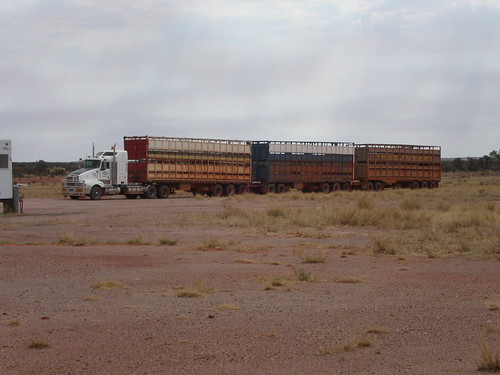
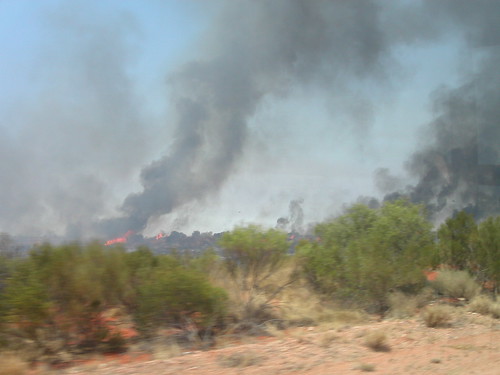
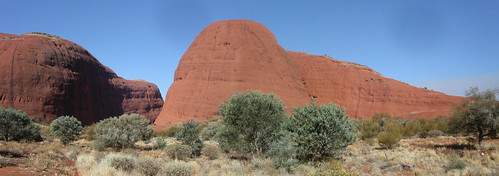
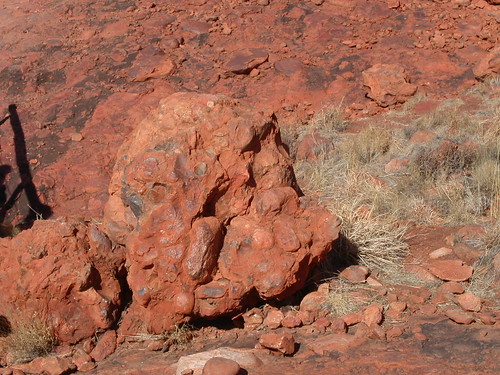
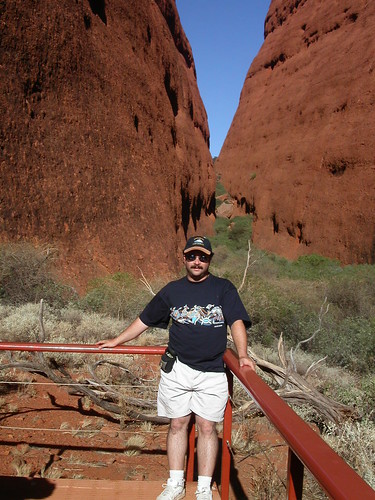

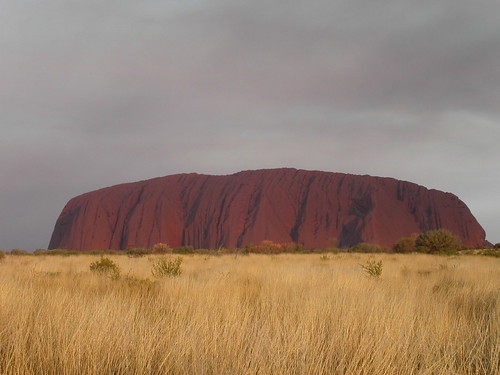

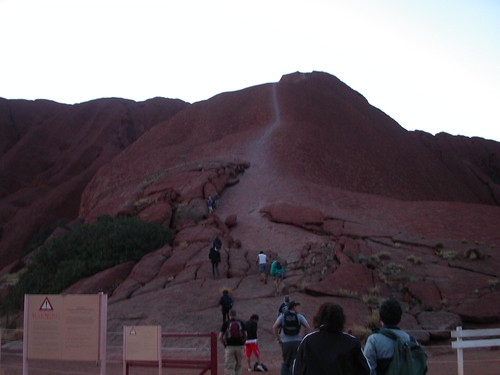
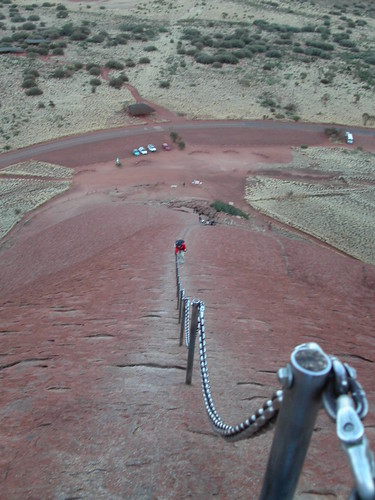
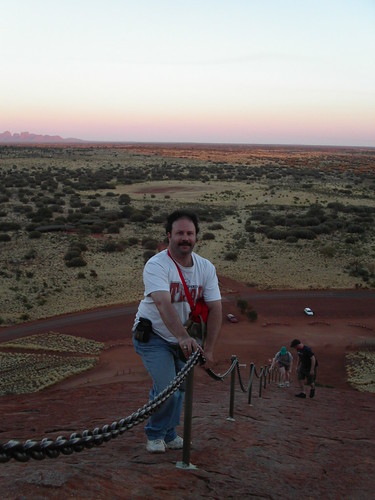
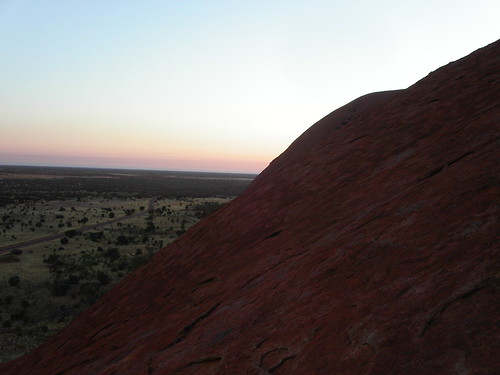


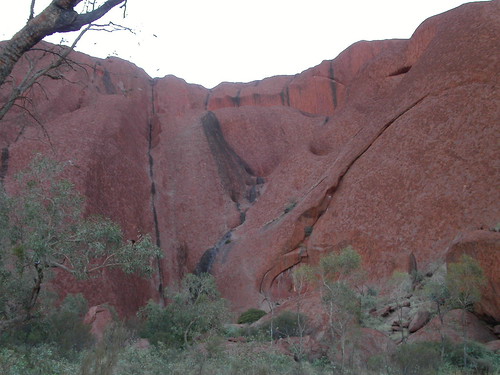


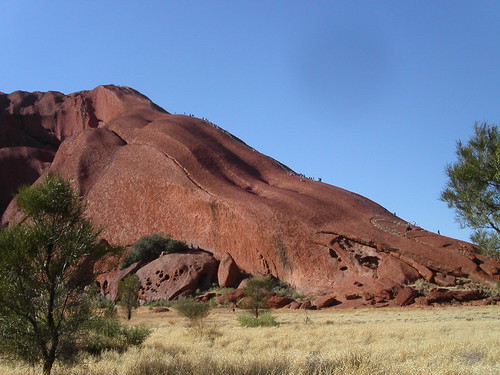
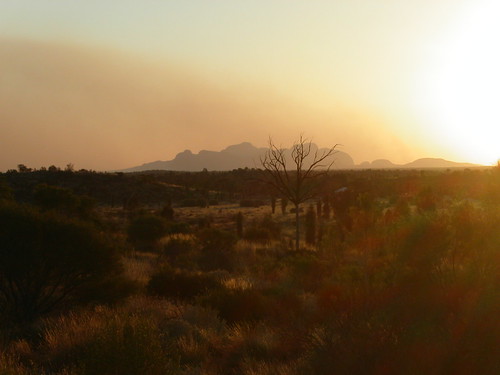
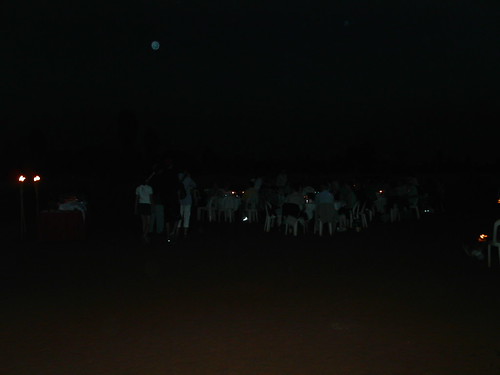



No comments:
Post a Comment